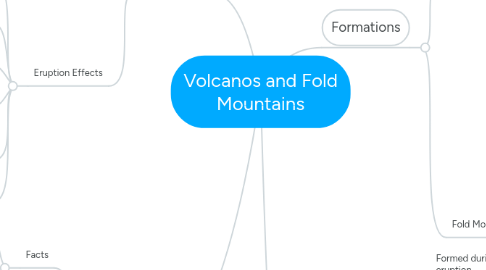
1. Alps
1.1. Facts
1.1.1. 11 million inhabitants
1.1.2. The economy is dependant on the environment
1.1.3. It is a tourist attraction in both the summer and winter
1.2. Economy
1.2.1. Forestry and Farming
1.2.1.1. The trees are coniferous. This means that their tress are pine needles. Since they are smooth, snow glides off them so the trees do not lose wood due to weaknesses
1.2.1.2. The land is not suitable for arable farming
1.2.2. Hydro-Electric Power
1.2.2.1. Power generated from falling water falling through a turbine
1.2.2.2. The water reserves from melting glaciers are channelled through pipes
2. Mt Etna
2.1. Facts
2.1.1. Active volcano
2.1.2. 3329m high (varies)
2.1.3. Between Eurasian and African plates
2.1.4. It has so many eruptions that they're are categorised by size, not frequency
2.1.5. The land is agriculturally rich
2.2. Eruption Effects
2.2.1. In 1928, the town of Masalli was destroyed by an eruption
2.2.2. Cable cars built for tourism kept being destroyed and rebuilt
2.2.3. In a 2001 eruption, the lava was 1000°
2.2.4. A 2002 ash cloud was visible from space
2.2.5. The lava had to be diverted by the Army after it reached tourist sites
2.2.6. At one point, the local airport had to be closed
3. Mt St Helens
3.1. Formed during a volcanic eruption
3.2. Between Juan de Fuca plate and North American Plate
3.3. Erupted in 1980
3.4. Months
3.4.1. March
3.4.1.1. Minor Earthquakes
3.4.1.2. Steam + Ash Eruptions
3.4.2. May
3.4.2.1. Swelling Mt (lava buildup)
3.4.2.2. Ash / Steam Eruption
3.4.2.3. Landslide + flooding
3.4.2.4. Magma blast
3.5. Effects
3.5.1. Peak decreased 390m
3.5.2. A crater formed, 3km wide and 1/2 km deep
3.5.3. Rivers filled with ash
3.5.4. No trees in the range of blast survived
3.5.5. 12% of crops ruined
3.5.6. 61 deaths by choking
3.5.7. Cars 100km away had engine troubles due to ash
4. Formations
4.1. Volcanoes
4.1.1. States
4.1.1.1. Extinct (won't ever erupt again)
4.1.1.2. Dormant (could erupt but isn't now)
4.1.1.3. Active (is erupting or about to)
4.1.2. Types
4.1.2.1. Shield
4.1.2.2. Composite cone
4.1.2.3. Cinder
4.1.2.4. Lava dome
4.1.3. Cross-section
4.1.3.1. Lava layers build up
4.1.3.2. Main vent (hole lava comes through)
4.1.3.3. Magma chamber (where lava stored)
4.1.3.4. Crater (opening)
4.2. Fold Mountains
4.2.1. Formed when two continental plates are pushed upwards
4.2.2. Examples
4.2.2.1. Alps (Europe)
4.2.2.2. Himalayas (Asia)
4.2.2.3. Rockies (North America)

